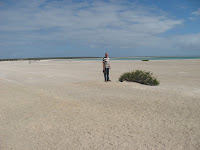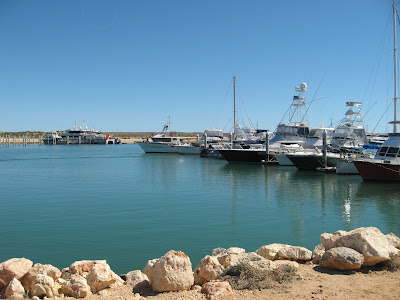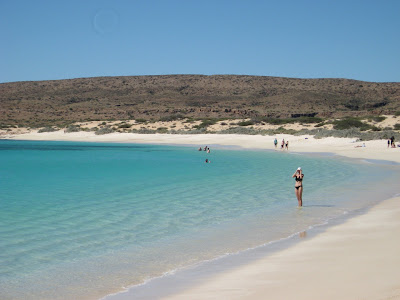...Hamelin Telegraph Station is the first stop on the Shark Bay World Heritage Drive. Leaving Wooleen Station early in the morning we said farewell to Anne and Roger who were travelling South to look for wildflowers. We had thoroughly enjoyed our 6 days with them and hope to catch up with them again later in the trip. We took the road back to Murchison Settlement and several kms north of the Roadhouse turned West on to Butchers Track. The track was sandy in parts but generally in good condition. From Wooleen to the North Coast Highway was 190km and we did not see one vehicle! We did see some beautiful wildflowers including masses of yellow everlastings and pink daisies.
We travelled north on the Coastal Highway, back over the 26th Parallel (we were back in the North West), and then west again on the Shark Bay Road which was the start of the World Heritage Drive. Over the next 3 days we thoroughly enjoyed exploring all of the significant sites on this drive.
Hamelin Pool Stromatolites
Shark Bay is one of only two places in the world where living marine stromatolites exist. The living fossils contain microbes similar to those found in 3,500million year old rocks - the earliest record of life on earth. We stayed next to the historic Telegraph Station which was a link in the line from Wyndham to Perth, and also linked with the overseas line at Broome. The walk to the stromatolites took us past a quarry where large blocks of cemented shells were mined.
Next morning we made a return visit to the beach and stomatolites before breakfast and at 9,00am set off for Denham. along the way we called in to Shell Beach. A beach made up entirely of tiny shells from animals known as Hamelin Cockles. The discarded shells have heaped into piles up to 10m thick and in some places the beach is 1km wide. The shells are mined for shell grit and paving material.
Eagle Bluff was our next stop with a boardwalk around the top of a dune that overlooks shallow water and meadows of sea grass. We saw a couple of turtles swimming and many cormorants on the 2 rocky islands.

We arrived in Demham, a quite lovely holiday town, for lunch then caught up with domestic jobs. Later in the day we rode along the waterfront and spent an hour in
World Heritage Discovery Centre. The Centre includes an excellent museum which covers all aspects of the Shark Bay District. Our entry entitled us to a revisit the following day.
 |
| Shark Bay World Heritage Discovery Centre |
 |
View from Denaham main street
We spent a very enjoyable morning at Monkey Mia despite the early start and the freezing wind. The Dolphins are fed at around 8.00am which meant leaving Denham soon after 7.00am. There was quite a lot of standing around waiting with a large crowd and the feeding itself was over pretty quickly. We did get a good look at them. After a coffee to warm up, we went on a sand dune walk which was lovely. Quite a few flowers, especially the big mauve daisies, six sightings of the Thick Billed Grass Wren which has come back from being extremely endangered in the National Park. Lovely views out to sea and a walk back along the low tide beach. In the afternoon we spent atwo more hours at the World Heritage Museum with a short break for a Magnum ice-cream.
|



Next morning was a 9.00am start at the Ocean Park Aquarium where our tour guide was a marine biologist. He was able to explain the habits and defence mechanisms of a variety of marine creatures. Highlights were the squid and seeing how they change colour as a defence mechanism and as a means of communication; the stone fish and the speed with which they take in any prey that swims past their noses; the lion fish with their poisonous feathery fins; and the cleaner fish who hold cleaner stations for large fish to come to - a bit like a car wash. After all this and also watching the sharks being fed, Merilyn says she is never going into the sea for a swim again - she'll stick to Huddart's pool.
First stop on our afternoon drive was at
Little Lagoon and a walk along the bank of the clear water creek that connects the lagoon with the sea. Almost perfectly circular in shape Little Lagoon was once a land locked gypsum pan that was inundated by the sea several thousand years ago.The pristine waterway is a natural nursery for several fish species.
Then on to Peron Homestead Historic Precinct and a walk around the shearing sheds and associated yards and buildings.
After three days we are moving on but feel that we might come back one day. There is still much to discover and it is a very lovely place. A flight over Dirk Hartog Island and a catamaran trip from Monkey Mia are both appealing.




























































